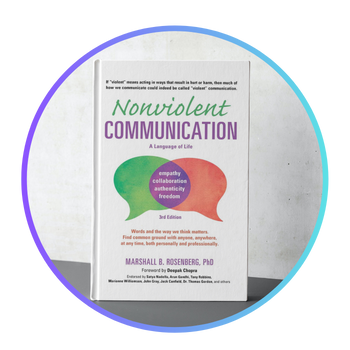
Today, we’re delving into Marshall Rosenberg’s transformative approach to communication – Nonviolent Communication. This method has the power to revolutionize how we interact with others, paving the way for more understanding, empathy, and ultimately, stronger relationships.”
Marshall Rosenberg’s “Nonviolent Communication” offers a structured approach to cultivate compassionate communication in our daily interactions, ultimately reducing conflict and nurturing harmonious relationships.
Key Concepts
Compassionate Communication for Enhanced Relationships:
The book introduces Nonviolent Communication as a means to transform everyday conversations that often lead to conflicts or feelings of neglect.
Example: Instead of reacting defensively when someone says, “You’re the most selfish person I’ve ever met,” one can employ Nonviolent Communication to understand the underlying feelings and needs.
Alienating vs. Compassionate Communication:
Rosenberg contrasts life-alienating communication, which creates barriers, with compassionate communication that builds bridges. It urges avoiding moralistic judgments and labels.
Example: Rather than labeling a daughter as “selfish” for wanting to move out, parents can engage in compassionate dialogue to understand each other’s needs and concerns.
The Essence of Nonviolent Communication:
Nonviolent Communication, inspired by Mahatma Gandhi’s principles, emphasizes connecting with others and oneself from a place of compassion, focusing on clear observation, feelings, and needs.
Example: When addressing a messy situation with a son named Jim, instead of immediately reacting with frustration, one can practice Nonviolent Communication by objectively observing the situation.
Observation and Evaluation Distinction:
The book stresses the significance of precise observation without generalizations or moralistic judgments. It offers techniques to engage the senses for effective communication.
Example: Rather than saying “You always…” to express dissatisfaction, one can refer to specific instances, like mentioning a particular incident where an action caused upset.
Expressing Feelings Clearly:
The book advocates for articulating feelings accurately using specific language, encouraging an expanded emotional vocabulary for clearer expression.
Example: Instead of vaguely stating, “I feel a bit down,” one can delve deeper to identify if they feel depressed, regretful, or betrayed, offering a more precise description of their emotions.
Taking Responsibility for Feelings:
Readers learn to take ownership of their feelings by recognizing their needs. The book provides examples of various reactions to challenging statements and offers a healthier way to respond.
Example: In response to being called “selfish,” one can choose to vocalize their own feelings and needs, fostering a more constructive conversation.
Identifying Needs for Effective Communication:
The book underscores the tendency to blame others for unmet needs, advocating for direct expression to promote understanding.
Example: Instead of berating a partner for being messy, one can communicate the need for an orderly environment and discuss practical solutions collaboratively.
Formulating Clear Requests:
The book emphasizes the importance of making requests in positive, concrete language to improve understanding and cooperation.
Example: Rather than saying “You’re spending too much time at work,” one can express the desire for specific quality time together, fostering a more constructive conversation.
Reducing Judgmental Self-Talk:
The book addresses self-criticism and offers a method to shift from self-judgment to identifying unmet needs, promoting self-compassion.
Example: When facing self-criticism for a small mistake, one can pause and identify the underlying needs that led to the self-judgment, offering a more compassionate perspective.
Empathetic Listening:
The book emphasizes empathetic listening, creating a safe space for others to express their emotions. It promotes reflection and paraphrasing for better understanding.
Example: Instead of immediately offering solutions, one can reflect the speaker’s words back to them, allowing them to expand on their message and facilitating a deeper connection.
Conflict Resolution with NVC:
The book provides a framework for conflict resolution, emphasizing the importance of establishing a human connection, honest intentions, and achieving satisfaction rather than compromise.
Example: In a dispute over responsibilities, both parties can identify their needs and work together to find a solution that meets both sets of needs, leading to a mutually satisfying resolution.
Take Away Advice:
Recognize your needs: When confronted with anger, take a moment to reflect on the source of your emotions. Ask yourself “Why am I angry?” to identify unfulfilled needs, regaining control of the situation and promoting more compassionate interactions.
I’d love to hear your thoughts! Have you ever tried applying Nonviolent Communication in your own life? Share your experiences in the comments below.
If you found this helpful, give it a like and share with someone who could use these techniques ! And don’t forget to grab a copy of the book for even more expert insights.
If you found the summary intriguing and wish to delve deeper into the insights of the book, you can use the links below to purchase your own copy:
International: https://amzn.to/3QOpT6K
Australia: https://amzn.to/46XSCM3
Also please consider subscribing to our socials – this way you are encouraging us to built more productive content.
Until next read, happy Nonviolent Communication!
